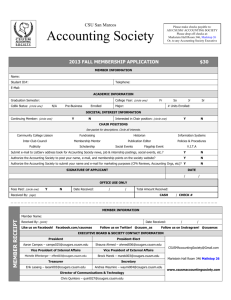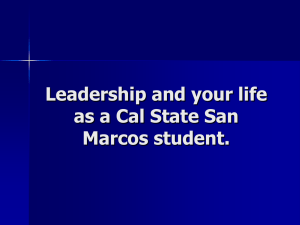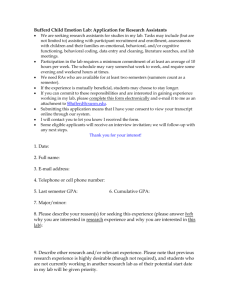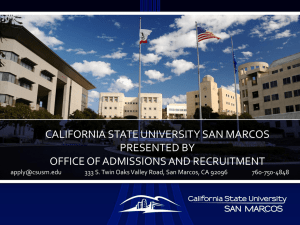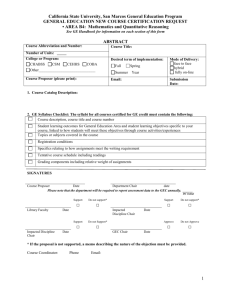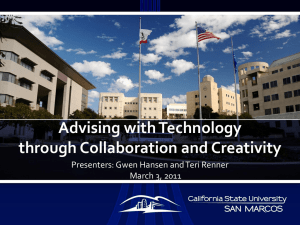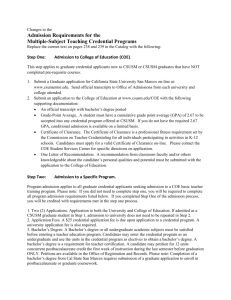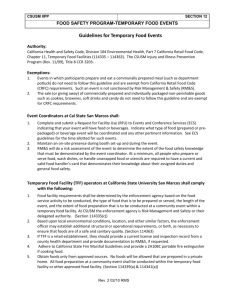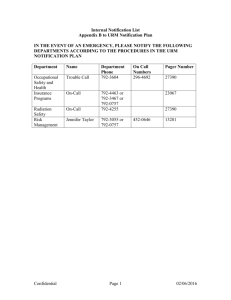CSUSM Essay #4 (Word Doc)
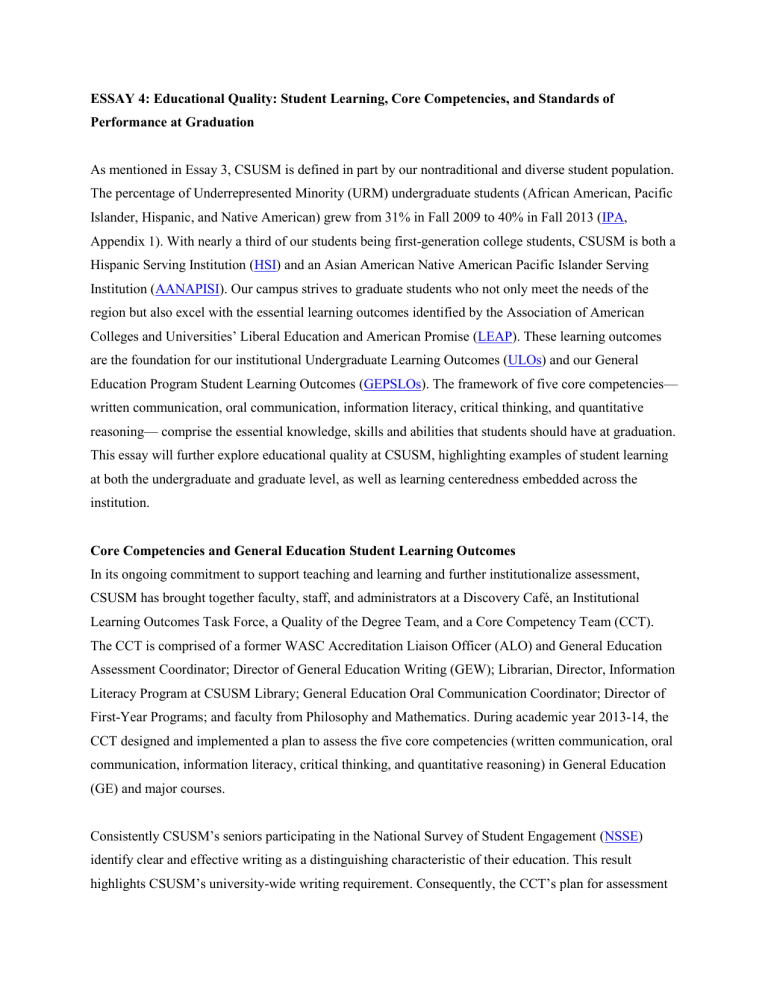
ESSAY 4: Educational Quality: Student Learning, Core Competencies, and Standards of
Performance at Graduation
As mentioned in Essay 3, CSUSM is defined in part by our nontraditional and diverse student population.
The percentage of Underrepresented Minority (URM) undergraduate students (African American, Pacific
Islander, Hispanic, and Native American) grew from 31% in Fall 2009 to 40% in Fall 2013 ( IPA ,
Appendix 1). With nearly a third of our students being first-generation college students, CSUSM is both a
Hispanic Serving Institution ( HSI ) and an Asian American Native American Pacific Islander Serving
Institution ( AANAPISI ). Our campus strives to graduate students who not only meet the needs of the region but also excel with the essential learning outcomes identified by the Association of American
Colleges and Universities’ Liberal Education and American Promise ( LEAP ). These learning outcomes are the foundation for our institutional Undergraduate Learning Outcomes ( ULOs ) and our General
Education Program Student Learning Outcomes ( GEPSLOs ). The framework of five core competencies— written communication, oral communication, information literacy, critical thinking, and quantitative reasoning— comprise the essential knowledge, skills and abilities that students should have at graduation.
This essay will further explore educational quality at CSUSM, highlighting examples of student learning at both the undergraduate and graduate level, as well as learning centeredness embedded across the institution.
Core Competencies and General Education Student Learning Outcomes
In its ongoing commitment to support teaching and learning and further institutionalize assessment,
CSUSM has brought together faculty, staff, and administrators at a Discovery Café, an Institutional
Learning Outcomes Task Force, a Quality of the Degree Team, and a Core Competency Team (CCT).
The CCT is comprised of a former WASC Accreditation Liaison Officer (ALO) and General Education
Assessment Coordinator; Director of General Education Writing (GEW); Librarian, Director, Information
Literacy Program at CSUSM Library; General Education Oral Communication Coordinator; Director of
First-Year Programs; and faculty from Philosophy and Mathematics. During academic year 2013-14, the
CCT designed and implemented a plan to assess the five core competencies (written communication, oral communication, information literacy, critical thinking, and quantitative reasoning) in General Education
(GE) and major courses.
Consistently CSUSM’s seniors participating in the National Survey of Student Engagement ( NSSE ) identify clear and effective writing as a distinguishing characteristic of their education. This result highlights CSUSM’s university-wide writing requirement. Consequently, the CCT’s plan for assessment
began with written communication in AY 2013-14, with the assessment occurring spring 2014. The cycle for the remaining core competencies is as follows: oral communication (Fall 2014), critical thinking/information literacy (Spring 2015), and quantitative reasoning (Fall 2015).
When developing the rubrics used for scoring the essay samples and the speeches and oral presentations for the written and oral communication assessments, the CCT held rubric-building sessions consisting of faculty from various disciplines. A different group of faculty was enlisted to actually score the essays.
This level of participation at the planning and implementation stages helps broaden faculty understanding of the University’s assessments efforts. The total sample size for this first round of core competency assessment was 122 papers (39 from GE, 83 from senior level major courses). Overall, the majority of students met the minimum standard for each criterion, with greatest strengths for purpose and audience/voice in the criteria (Appendices 2 and 3).
The CCT shared the assessment data with various entities across campus including all college deans and the University Assessment Committee (UAC). Conversations about how this snapshot of CSUSM’s graduating seniors’ written communication skills can help faculty revisit their own classroom practices, aid departments/programs in examining how they support writing in their curriculum, and help the
University reevaluate the curricular structures that support writing across the disciplines are beginning. In other words, CSUSM is looking at “closing the loop” as it moves forward with assessment of the remaining core competencies. The CCT recruited an even larger sample size of 241 samples of in-class student presentations for the oral communication assessment in Fall 2014 (see Appendix 4 for rubric).
Furthermore, in keeping with the California State University Executive Order 1065 on GE Breadth
Requirement, our General Education Committee (GEC) brought General Education Student Learning
Outcomes to the Academic Senate in Spring 2014. Again, these GEPSLOs are rooted in the LEAP core competencies mentioned above, with GEPSLOs #3, 5 and 6 on written communication, oral communication, and information literacy already required in all GE courses (Appendix 5). GEC’s next step is to begin curriculum mapping of these GEPSLOs across the GE courses—specifically, upper division courses— to demonstrate that indeed these student-learning outcomes are being addressed across the curriculum.
Evidence of Undergraduate Student Learning
A wide range of strategies is used by the University to confirm that students meet key learning outcomes, particularly at the programmatic level. One example is the Biology Department’s work to assure that its
2
majors learn to “Apply quantitative reasoning to analyze and solve complex problems” (
ULO 2b ).
Supported by a National Institutes of Health MARC Curriculum Improvement Grant from 2008-2013,
CSUSM faculty modified a total of 17 Biology courses, 6 Chemistry courses, 3 Mathematics courses, 2
Physics courses, and 2 Computer Science courses to increase quantitative and computational concepts and analyses related to the Biological Sciences. All of the modified courses are requirements or electives for
Biology majors, ensuring that students in the major are introduced to quantitative reasoning and analysis early in their college careers, and that key concepts are reinforced multiple times during their coursework.
A summary of the quantitative and computational modifications made to a single course (BIOL 210) is included in Appendix 6. Although evaluation of project assessment data is ongoing, student knowledge surveys have suggested substantial gains in student confidence with quantitative and computational concepts after completing modified coursework (Appendix 7). Beyond individual course modifications, another outcome of this project was the development of a new Quantitative and Computational Biology
Minor, offered for the first time in Fall 2014. Thus, targeted and thoughtful efforts are underway to strengthen quantitative reasoning and problem solving in the Biological Sciences, and these efforts are representative of a broader University-wide commitment to assure that our students meet key learning outcomes.
Another programmatic example is our College of Business Administration, in conjunction with 7 other
CSU campuses, using a Business Assessment Test (CSU-BAT) to assess student-learning outcomes in business classes from accounting to management and marketing. In Spring of 2012, the annual assessment report for our BS in Business Administration noted that the average scores the CSU-BAT were the highest CSUSM students have received since we began participating in the assessment in 2005.
A further demonstration of student learning is the capstone Senior Experience for Business students. In an intensive, integrated course, teams of students apply their classroom-based knowledge to complete a consulting project with a real-world business problem, proposing solutions for their sponsoring business.
For example, Senior Experience teams identified areas to increase sustainability efforts of the local ecoconscious Stone Brewery.
Additional evidence of student learning is gathered at the institutional level through three national surveys
CSUSM administers: The Freshmen Survey (administered to incoming first-year students), The Senior
Survey Surveys (administered to graduating students), and the National Survey of Student Engagement or
NSSE (administered to freshmen and graduating seniors in their spring term). These surveys provide insight into how students self-report their skills on written and oral communication skills, and on time spent writing and presenting. NSSE responses to the National Survey of Student Engagement illustrate
3
our students’ assessment of their writing and speaking skills compared to other participating California
State Universities. For NSSE 2014 results, see Appendices 8, 9, and 10 (“Snapshot,” “High Impact
Practices,” and “Engagement Indicators”).
Because our campus administers both the Freshmen Survey and the Senior Survey, the Higher Education
Research Institute is able to provide responses to both surveys by the same students at these two different points in their college careers. As was the case in 2009 and 2011, the results for the spring 2013 Senior
Survey show that the percentage of CSUSM respondents who rated their written and oral communication as “above average/highest 10%” increase substantially between their freshman and senior years:
Writing ability: 48% of freshmen vs. 66% of seniors
Public speaking ability: 33% of freshmen vs. 42% of seniors (Appendix 11).
2014 National Survey of Student Engagement
My college education has contributed "very much or quite a bit" to my knowledge and skills in the following areas
Freshmen Respondents
Cal State
San Marcos
Other CSU
Campuses
Senior Respondents
Cal State
San Marcos
Other CSU
Campuses
Thinking critically and analytically
Writing clearly and effectively
Speaking clearly and effectively
Analyzing numerical & statistical information
88%
81%
83%
66%
78%
70%
78%
58%
Estimated number of assigned pages of student writing
Often/Very often gave a course presentation
63
62%
42
45%
2014 National Survey of Student Engagement
86%
79%
71%
68%
95
63%
My college education has contributed "very much or quite a bit" to my knowledge and skills in the following areas
Freshmen Respondents
Cal State
San Marcos
Other CSU
Campuses
Senior Respondents
Cal State
San Marcos
Other CSU
Campuses
84%
73%
70%
65%
82
62%
Thinking critically and analytically
Writing clearly and effectively
Speaking clearly and effectively
Analyzing numerical & statistical information
88%
81%
83%
66%
78%
70%
78%
58%
86%
79%
71%
68%
84%
73%
70%
65%
Estimated number of assigned pages of student writing
Often/Very often gave a course presentation
63
62%
42
45%
95
63%
82
62%
As part of a system-wide initiative, CSUSM also administers the Collegiate Learning Assessment (CLA) to incoming freshmen and graduating seniors each year. The CLA is designed to “measure an institution’s contribution, or value added, to the development of higher-order-skills” such as critical thinking and
4
written communication. In Spring 2014, 65 seniors took the test and results show that CSUSM’s total
“Value-Added Percentile Rank” was better than 80% of other participating campuses (Appendix 12). The data from these surveys, in particular when comparing freshmen to seniors, indicate growth and student learning at graduation. And we continue to look for areas in which we can further institutionalize assessment from the programmatic level on up, a topic addressed more fully in Essay 6.
Evidence of Graduate Student Learning
During the process of establishing our Institutional Learning Outcomes , the distinction between undergraduate and graduate student learning outcomes become clearer. Beyond the core competencies, there are consistent themes within our graduate programs that may eventually inform the foundation for graduate student learning outcomes at CSUSM. Our graduate programs are committed to: 1) development of professionalism and career readiness; 2) community engagement; 3) ethical and responsible practice; and 4) producing scholars.
One example of the manifestation of developing professionalism, career readiness, and community engagement is from the Master of Arts in Education, Option in Communicative Sciences and Disorders
(CSD). Graduates entering the field of CSD are expected to develop knowledge and skills in nine main areas of clinical practice, first learning content knowledge in the classroom, and then through field placements where students develop their clinical skills through direct service provision. Through community collaborations with the San Marcos Unified School District, Palomar Pomerado Health and
Learning Services (a residential center for individuals with brain injury), faculty take students out to engage in scaffolded skill development in ecologically valid settings. For example, as part of the language disorders and swallowing disorders courses, students are provided with ample opportunity in the course to practice language and swallow evaluations on one another. They then apply their knowledge and skills to volunteer residents at Villa Pomerado Care Center. The students gain vital experience with reviewing patient charts, conferring with nursing staff, charting and providing oral reports during this exercise. This provides a real world opportunity for students to begin applying the knowledge and skills they are developing in class to professional practice. The program uses low-stake assessment measures for this assignment in that students are provided with significant feedback on their written charting and their oral presentations without a final grade to emphasize the process. The feedback from this activity is expected to be used in subsequent settings and is assessed more formally at that time. Reflections from our students and our off-site supervisors have been overwhelmingly positive. As one student put it:
As an SLP graduate student I have been provided examples of how various clinicians “swim,” informed how one’s “arms and legs should move” in order to obtain the intended result, and have been allowed to practice on my colleagues, but until I had experienced working with members of
5
the community with communication difficulties, I felt myself to be at a disadvantage […] My experience at Villa Pomerado has provided me with increased confidence in my clinical abilities due to hands-on experience with clients who have true communication difficulties (at times with one or more concomitant factors), the otherwise inaccessible insight into my clinical style, and both spoken and unspoken reassurance by CSUSM faculty that I have their support and am developing the skills necessary to swim on my own. (Appendix 13)
Other graduate programs such as Social Work, Business Administration, Psychology, and Sociological
Practice utilize similar engagement scholarship strategies, hands-on application of content knowledge in real world settings that enhance student learning, career readiness, and professionalism while working collaboratively with community partners.
Closing Achievement Gaps
A third of incoming CSUSM students are the first in their family to attend college. Many incoming students are also deficient in math and writing skills, with >30% requiring math remediation before taking a college-level math course and >40% requiring writing remediation before taking a college-level English course. The CSUSM Office of First-Year Programs coordinates a diverse group of activities designed to help our new students to more effectively transition to the academic and social norms of college. Central to this effort is the GEL 101 course (The Student, The University, The Community), which is taken by
~70% of first-year students. This course explores the time management, writing, and study skills integral to success in college and helps students to investigate career options associated with their major. First-
Year Programs also coordinates a range of first-year learning communities in which students enroll in at least two linked courses, one of which is a section of GEL 101. Each first-year learning community addresses a unique theme (e.g. Global Learning, Business), both inside and outside of the classroom.
Even before students begin their first official semester at CSUSM, summer programs are offered that assist first-year students with achieving proficiency requirements in English and Math: Summer Academy and Mathematics Acceleration Program in the Summer (MAPS). Collectively, these programs have helped improve transfer student 1-year continuation rates from 76% (2000) to 85% (2012) and freshman
1-year continuation rates from 60% (2000) to 80% (2012). See Appendices 14 and 15 for further data.
Another example of closing the achievement gap on campus is our Supplemental Instruction (SI) program in the sciences. Specific lower-division classes covering conceptually difficult material (e.g. calculus, first-semester general chemistry, and first-semester molecular/cellular biology) have a high student fail rate. This is a nationwide problem, and these courses can act as a significant barrier to student success in
STEM majors, leading to decreased retention, changes in major, and/or increased time to degree. While a variety of strategies and course modifications within the classroom have been carried out to help improve
6
student performance in these classes, perhaps the most impactful program has been Supplemental
Instruction . The SI program is designed to help students in historically difficult classes to master course content while they develop and integrate new learning and study strategies. SI Leaders are paid students
(nominated by faculty) who are trained in proactive learning strategies, attend all course lectures, and conduct biweekly student-centered review sessions that are open to all students in a particular course. At
CSUSM, the SI program focuses on 11 historically difficult science courses, and in the past year the program has reached >700 students with >5000 total student contact hours.
The results of the SI program at CSUSM have been striking: students who attend SI sessions have ~40% lower fail rates than non-participants, and their course performance is typically a full grade point higher than non-participants. Although the SI program was initially supported at CSUSM primarily through external grant funding (as a component of a National Institutes of Health RISE grant), the program has been fully funded by the University since 2007. Overall, the SI program provides a model of the
University’s approach to addressing achievement gaps: establish fledgling student support programs using either internal or external funds, quantitatively assay student outcomes, and institutionalize programs which substantially improve student performance and help to “close the gap.”
In 2009, CSUSM joined the CSU system in a national “ Graduation Initiative
” effort to increase 6-year graduation rates for students while also “closing the gap” between rates of URM students and non-URM students. Starting from a 6-year graduation rate for students entering CSUSM as freshmen in Fall 2000 of
37% (35% for URM and 37% for non-URM), CSUSM set a goal of increasing this rate to 45% for all students by 2015. We achieved our overall goal of 45% for the entering class of 2004; however, the gap between the graduation rates of URM and non-URM students remained. As of Fall 2013, the 6-year rate for freshmen entering in Fall 2007 was 38% for URM students and 46% for non-URM students. We anticipate seeing an increase in these rates as we have seen the 1-year continuation rate improve from
57% for freshmen entering CSUSM in Fall 2000 to 67% for Fall 2006 entrants to 81% for Fall 2012 entrants. In addition, the gap between the one-year continuation rates for URM and non-URM students closed for students entering in Fall 2009 and 2010 and has remained small in subsequent terms (see
Appendix 16 for student characteristics).
The campus set similar goals for students entering as transfer students. Although their six-year graduation rates are already higher than those for first-time students, we intend to raise those rates from 65.2% for students entering in Fall 2000 to 71.4% for students entering in Fall 2009. Our overall rates have improved but the gap between URM and non-URM students remains. The most recent 6-year graduation
7
rates (for students entering in Fall 2007) are 43.5% overall and 38% for URM students and 46% for non-
URM students.
Improving Teaching and Learning Through Assessment
We have two primary ways in which we improve our teaching and learning practices. The first is through faculty review. Faculty, including tenure track and lecturers, are required to submit an annual Working
Personnel Action File (WPAF) in which they discuss their teaching practices. The faculty member develops a narrative statement that is expected to include a critical analysis of the student feedback from course evaluations, any peer or supervisor observations, and a self-reflection. As part of this process, the faculty member should explain the steps that he/she will take to improve instructional practices. This
WPAF is then reviewed by a department chair or college level Peer Review Committee (PRC), college
Dean, and depending on the faculty status and level of review, the Promotion and Tenure Committee
(PTC) and Provost. At each level of review, faculty members are provided with constructive feedback regarding their file, which includes recommendations for improved instructional practices. The WPAF review letters become part of the faculty member’s subsequent WPAF and are considered in the next year’s review. As such, faculty members are held to implementing their own proposed changes and the recommendations from reviewers. For tenured faculty, this review process is completed every five years.
The second way that we improve instructional practices is through program review (further discussed in
Essay 6 of this self-study). One example of the use of assessment findings to improve teaching and learning practices comes from the Master of Arts in Education. Program faculty hold two annual weeklong retreats to reflect on and analyze survey data from current students, alumni, supervisors, and employers, as well as collective observations over the performance of students towards program learning outcomes. Based on survey data from students and supervisors, faculty noted a protracted timeline for the student development of professional writing skills. As a result of these assessment findings, the program developed a writing workshop to provide early preparation for our incoming graduate students. In Spring
2014, prior to the start of their first semester, graduate students attended the first component of the writing workshop on how to read and dissect a research study, with particular focus on the style and format, mechanics, content and organization, and synthesis and critical analysis. In June and July, students completed online writing assignments where they deconstruct an article and then write an argumentative piece aimed at convincing an audience of their position. These papers were then graded on a rubric related to the four focus elements, and faculty created lesson plans for common areas needing improvement.
Finally, the students engaged in a revision process based on the lessons provided. The data from this first application has not yet been reviewed; however, the subjective feedback from students has been positive.
8
Further evidence of improving teaching and learning based on assessment is the four degree programs submitted for WASC substantive change approval. In Spring 2014, the proposals of three existing programs— the Bachelor of Arts in Sociology, the Bachelor of Arts in Criminology and Justice Studies, the Bachelor of Arts in Social Sciences, and one new online program option, the Bachelor of Science in
Nursing (RN to BSN option)— were all approved (Appendices 17-19). In the case of the three existing programs, faculty discovered that course expansion over time made it possible for students to complete
50% or more of their major requirements through online and hybrid courses, which required formal
WASC consideration. Upon their approval of the programs, WASC reviewers praised the departments involved for taking their program reviews seriously and using them to determine that substantive change applications were necessary. In addition, WASC reviewers were pleased that faculty used prior assessments to consider how pedagogical and assessment design could best address the changes to their delivery methods and expansion of their programs.
Learning Centeredness Across the Institution
Faculty, staff, and students at CSUSM take learning-centeredness seriously, which is evidenced through multiple, and often intersecting, campus efforts. The Office of Civic Engagement , creates opportunities for service learning that strengthen the university’s connection with the greater community, while providing students with experiences that bridge learning inside and outside of the classroom. Students are paired with non-profit organizations and schools and complete internships that supplement and reinforce the knowledge imparted in their coursework. These experiences deepen their understanding of their fields of study, and often provide them with invaluable knowledge about graduate school and future work opportunities, as noted by student Mathew Jerome: “Interfaith [Community Services] provided me the experience I needed in the field to enter the job market with a necessary set of skills to obtain employment. I also was accepted into the MSW program at the University of Southern California. I think the experience I gained from Interfaith greatly contributed to that.” The diversity of field placements offered allows students to enjoy a wide range of involvement in the professional and scholarly life of our community ( list of over 300 participating sites ). Community Engagement provides service-learning faculty with training and special resources to help them enhance the learning experiences around the students’ community service.
The Faculty Center provides additional professional development opportunities for faculty who are interested in improving their methods of instruction. Numerous workshops and lectures are offered each academic year on a variety of pedagogical topics by the Faculty Director, CSUSM faculty, and guest
9
facilitators, such a Spring 2014 workshop, “Teaching in the 21 st Century.” In addition, the Faculty Center runs a Faculty Mentoring Program that pairs first-generation and economically challenged college students with faculty members across the University in mentoring relationships. The program is focused upon building supportive relationships between faculty and students that will help build students’ educational resilience and their academic skills. Faculty mentors and students are paired based upon their areas of expertise and major area of study, which facilitates the communication of discipline-specific advice between them.
A campus-wide effort known as the Civility Campaign addresses some of the overarching social factors that affect student learning. This campaign, which as been in effect since 2012, is an effort to create a safe, supportive environment for the campus community through curriculum and events stressing care, mutual respect, and empathy; its centerpiece is a student pledge to support those values. The Office of
Student Affairs (further discussed in Essay 5) focuses on helping individual students sharpen their academic skills through the tutoring provided in language, writing, and math labs.
Other instructionally related activities outside of the classroom also reinforce learning in the classroom and the University’s goal of promoting a well-rounded educational experience. The Arts and Lectures
Series is a yearly series of 20-30 events, including talks, films, performances, concerts, book readings, and scientific discussions that draw upon the expertise of scholars and artists. These events are often used as touchstones for discussions inside and outside of class time in order to deepen students’ comprehension of course concepts (see Appendix 20 for Fall 2014 series). The Context Library Series presents art and visual representations of a given theme in an exhibit on the main floor of the library and a number of learning-centered activities, such as lectures by the artists, attendance at expert panels, and activities/assignments that are integrated into the coursework of participating classes ( all previous exhibits ). For example, the exhibits from the 2013-14 academic year, The Uterus Flag Project and More than a Fence: (de)Constructing Mexico/US Borders, inspired scholarly discussions related to a wideranging number of disciplines, including feminist studies, health studies, ethnic studies, sociology, visual arts, communication, and law.
The Office of Graduate Studies and Research hosts the annual Symposium on Student Research, Creative
Activities, and Innovation , which allows selected undergraduate and graduate students across the
University to present their scholarly work to a panel of professional expert judges. A selection of up to ten finalists is chosen to compete in the statewide CSU competition; historically, our finalists have often placed first or second in their divisions at the competition. Students benefit by increasing their knowledge
10
in their field as they learn from their peers across the Cal State University system. Other similar opportunities for students to present their scholarly work include the Council for Undergraduate
Research’s bi-annual
Student Poster Showcase , and discipline-specific events, such as the Psychology
Research Fair, the Global Studies Research Fair, and the Nu Epsilon Research Fair in Human
Development.
Prepared in Summer-Fall 2014 by Melanie Chu, Catherine Cucinella, Matthew Escobar, Suzanne
Moineau, Pat Morris, and Richelle Swan.
11
